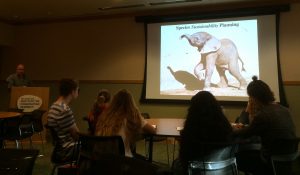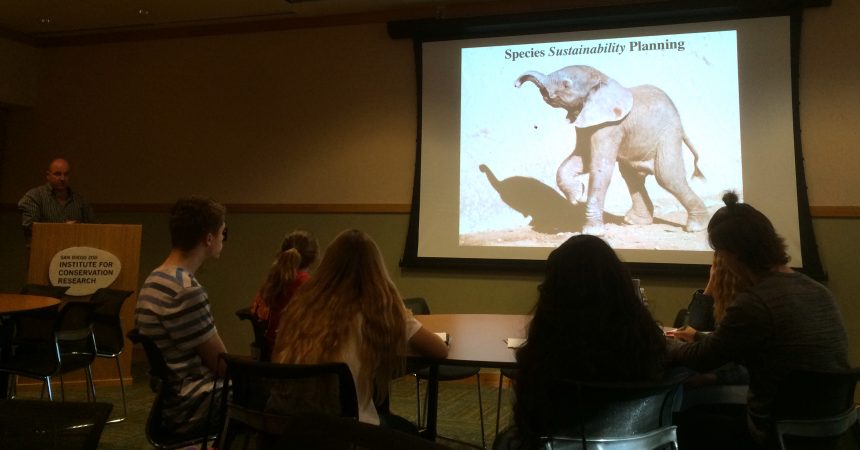Zoo InternQuest is a seven-week career exploration program for San Diego County high school juniors and seniors. Students have the unique opportunity to meet professionals working for the San Diego Zoo, Safari Park, and Institute for Conservation Research, learn about their jobs, and then blog about their experience online. Follow their adventures here on the Zoo’s website!
 When I think of the sounds elephants make, the first noise that comes to mind is their classic trumpet call. This week, I was astounded to learn that elephants also make another vocalization more frequently: their rumble call. Their trumpet call is used primarily as an alarm sound to alert the rest of the herd to potential danger. Due to its high frequency, it is only audible within close distances. Contrastingly, their rumble call has a much lower frequency, meaning the sound waves are able to travel much farther distances. Crazy enough, if it weren’t for traffic noise, elephants between the Zoo and Safari Park could communicate! About two-thirds of this call is below twenty hertz, which is considered infrasonic, or inaudible to humans. Therefore, scientists have relied on advanced technologies to gain a better understanding of this vocalization and its behavioral context.
When I think of the sounds elephants make, the first noise that comes to mind is their classic trumpet call. This week, I was astounded to learn that elephants also make another vocalization more frequently: their rumble call. Their trumpet call is used primarily as an alarm sound to alert the rest of the herd to potential danger. Due to its high frequency, it is only audible within close distances. Contrastingly, their rumble call has a much lower frequency, meaning the sound waves are able to travel much farther distances. Crazy enough, if it weren’t for traffic noise, elephants between the Zoo and Safari Park could communicate! About two-thirds of this call is below twenty hertz, which is considered infrasonic, or inaudible to humans. Therefore, scientists have relied on advanced technologies to gain a better understanding of this vocalization and its behavioral context.
While this information is extremely fascinating, it also has some very valuable applications in the world of conservation research. Matt Anderson, Director of Behavioral Ecology at the Institute for Conservation Research, discussed with us how his work contributes to the conservation and reproductive success of endangered species. Behavioral Ecology is the study of how animals perceive one another and their environment. At the Institute, this department utilizes pioneering science, such as sensory ecology and hormone mapping, in order to augment the conservation efforts of the African elephant.
Elephants currently face an array of threats including habitat loss, poaching, and human-elephant conflicts. In 2003, multiple herds of African elephants were living in a protected region of Swaziland, which overtime led to overpopulation. In turn, human-elephant conflicts were on the rise, and locals were beginning to cull the herds. However, the Zoo responded by rescuing a herd of elephants that was scheduled to be culled by government officials. Once within the Zoo’s care, Dr. Anderson’s team utilized non-invasive GPS mapping and sound recorders on the elephants. This technology gathers information on the dynamics of their social hierarchy, specifically juvenile interactions, mom and infant interactions, and herd communication. Researchers learned that the more dominant elephants move around the enclosure much less than the subordinate elephants. Also, other technologies have allowed scientists to take a closer look at the elephants’ rumble call. Through the use of spectrographs, which offer visual representations of sound frequencies, experts have been able to differentiate between the varying inflections of the infrasonic vocalization. Behavioral ecologists have concluded that this call has two main purposes: to announce the breeding season and alert the herd of an approaching birth. Females rumble to attract solitary males for breeding, and when a female elephant is in the last ten days of her pregnancy, she will rumble to mobilize the rest of the herd to offer additional protection.
Through better understanding elephant patterns and behaviors in controlled conditions, scientists can then apply this knowledge to their counterparts living in the wild. Dr. Anderson hopes that research related to elephant communication will soon be applied outside of the Zoo. By playing back recordings of rumble calls, Mr. Anderson hopes to encourage elephants to relocate from less vulnerable, overpopulated areas to regions that offer elephants more stable conditions. Oxford University led a project that involved playing back recordings of bee sounds, a noise that elephants inherently hate, to drive them out of crop areas. Unfortunately, however, this only caused the elephants to relocate to neighboring crops and farms. Dr. Anderson believes that attracting the elephants out of the way instead of scaring them will produce more effective results. The goal is to ultimately decrease the rate of human-elephant conflict and allow wild elephants to thrive more successfully in their natural habitat.
While the conservation efforts of Dr. Anderson and the Behavioral Ecology department may seem slightly out of reach to the average person, there are plenty of ways to deepen our conservation involvement beyond the parameters of reduce, reuse, and recycle. Don’t get me wrong, it is very important to try to reduce the waste we leave behind. However, protecting and preserving wildlife is just as important and all too often, the forgotten half of the equation. Volunteering for programs like Project Wildlife and Citizen Science are a great way to make a positive contribution. Project Wildlife is a local non-profit that focuses on improving the quality of life for native wildlife through animal rehabilitation. On a more global scale, Citizen Science is an internet-based collaboration of research and science projects. Through their Zooniverse projects, anyone can become involved in their people-powered research. On another note, simply by spending time reading these blogs, each of us is actively choosing to inform ourselves of these important ongoing issues. By expanding our own knowledge and involvement, we can begin spreading the word about conservation efforts and encourage others around us to follow in our footsteps.
Jasmine, Conservation team
Week Two, Winter Session 2017


